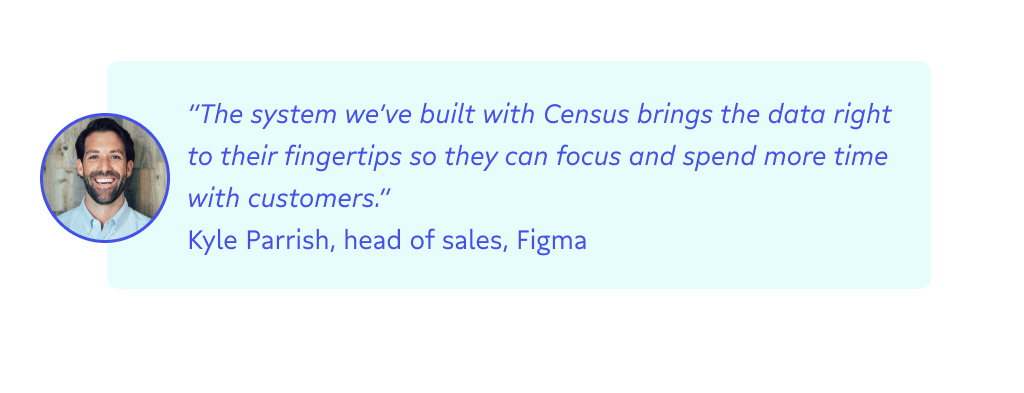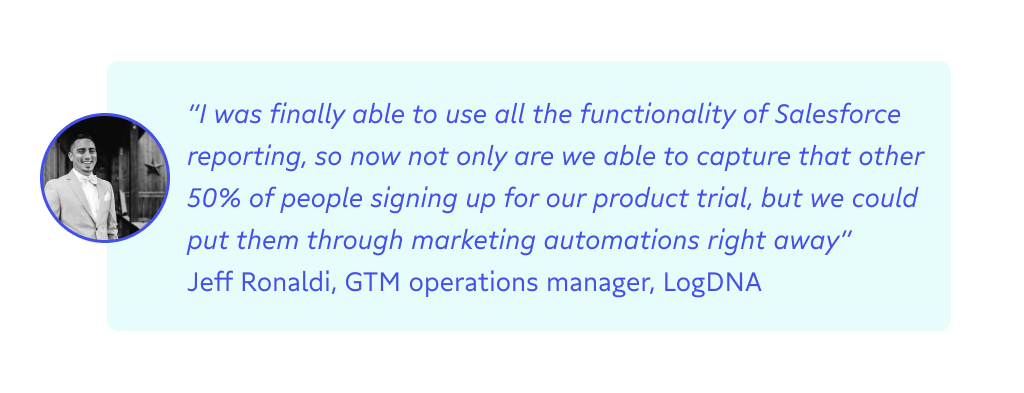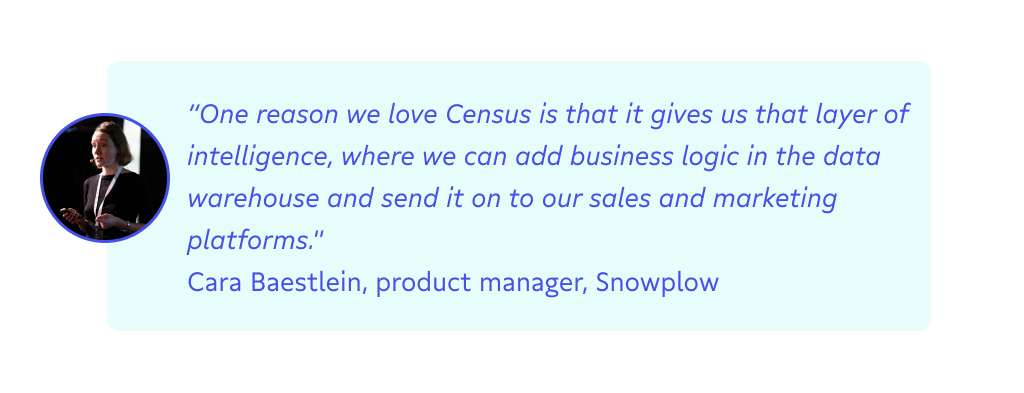This article is part of our good to great series highlighting some of the amazing things cutting-edge companies have done with reverse ETL to operationalize their data. We've also featured marketing and data team stories. 😍
The product-led growth era has fundamentally shifted the challenges sales teams wrestle, and the last two years of virtual selling have catapulted us even further down the road of customer-first strategies.
It’s harder than ever to build trust with leads thanks to virtual points of contact and self-serve product adoption. For teams selling to enterprise customers, you have to work faster than ever to connect with key decision-makers.
The reality is a good product alone isn’t enough to close deals anymore. You need to lay the groundwork for a good relationship with and good experience for your prospects on day one and demonstrate you know what they want and need. Thankfully, data can help.
Here’s how three industry leaders—Figma, LogDNA, and Snowplow Analytics— overcame modern sales challenges with data and reverse ETL.
Figma: Conquering the beast of customer insights
Figma, an online graphic design editor and prototyping tool, is a favorite among millions of dedicated users. And it relies on its enterprise sales team to accelerate growth within a PLG model.
Started in 2017, Figma has empowered designers to use its product to make design between coworkers more collaborative. With this product-first approach has come some data and sales challenges that, up until reverse ETL, they were struggling to overcome.
Namely: The Figma sales team was wrestling with a way to identify and route freemium users based on product usage that fit their ideal customer profile (ICP) with high-revenue potential. They were having trouble finding the right sales leads who were ready to buy among their millions of users.
To do this, they needed to do two things:
- Create a unified account hierarchy model to give each AE a complete view of each user’s organization.
- Create a customer health score based on product data to identify high potential or high-risk accounts.
And to do these two things, they needed reverse ETL to help them move user data from their warehouse (Redshift) into Salesforce and Google Sheets to create 360-degree customer views, PQLs, and health scores.
With this data in hand, AEs could see what features customers used most to educate prospects, prevent churn, and create opportunities quickly.
By exposing all the product data in SFDC, Figma’s sales team uncovered upsell opportunities from existing accounts and knew how each of their customers used the product, all without leaving the tool they loved (Salesforce).

Figma’s modern data stack allowed Kyle Parrish, head of sales at Figma, and his sales team to create three things:
- Unified account hierarchies to link all Figma teams and organizations together with a single account, which a single rep could work.
- 360-degree views of customers to help sales reps figure out which leads and customers they needed to prioritize. They further enriched this data using Clearbit (we love ourselves a good crossover episode 🥰) to find users working in Fortune 500 companies.
- Lead scoring to keep AEs focused on the right accounts at the right time based on first- and third-party enrichment data, PQL scoring, and a customer health score model. These models could easily be updated with new formulas as strategy shifted, so the sales team was always up to date.
“Arming a sales person with usage stats and key personas led to 10x better discovery calls.” Kyle Parrish, head of sales, Figma
Furthermore, improvements to Figma’s data stack with reverse ETL made it possible for the ops team to operationalize data to route leads to AEs based on configuration thresholds and rules while still respecting the existing book of business owners. They were also able to alert AEs and AMs when customers achieved major usage milestones.
Finally, the addition of reverse ETL eliminated the need for daily, manual sales data updates in Google Sheets, instead giving the team access to real-time sales forecasting automatically.
All of this meant less tool frustration and a faster, more straightforward sales process. Figma truly proved an investment in data-driven sales pays dividends by increasing the sales team’s productivity.
✅ Improved understanding of what features customers loved most.
✅ Unified understanding of customers and the organizations they belonged to.
✅ Clear picture of which leads had the most potential.
✅ Improved AE and AM focus with lead scoring.
✅ Real-time sales forecasting in Google Sheets.
✅ Roll-over benefits for the marketing team, too!
Want to learn more? Check out Figma’s full customer story here.
LogDNA: Overcoming the myth of unavailable insights
LogDNA helps enterprise DevOps teams manage their systems and application logs in one central service. When they started looking for reverse ETL, the team wanted to get data from their warehouse (Redshift) to Salesforce so the sales team could tap into 360-degree customer views and lead scoring.
Jeff Ronaldi, GTM operations manager, frequently worked with product management, RevOps, sales, marketing, and data teams at LogDNA to get sales the insights they needed to better understand and serve their customers. However, their tooling was siloed, and no matter how many conversations he had, there wasn’t an easy way to tie everything together.
This meant when sales had a fundamental question about customers, there wasn’t an easy way to get at the answer as information wasn’t getting logged into Salesforce.
To find a stop-gap solution to count the number of trial users they had, Jeff started manually checking and pulling information from HubSpot and other tools and comparing invoice data in Stripe with Salesforce. This was when he noticed another problem: Leads were falling through the cracks and not being logged in Salesforce.
Bandaid #2: Engineering would go into MongoDB and export information weekly, and then Jeff would re-format it manually and import it into Salesforce. This was— as you can guess—not sustainable (and, honestly, pretty annoying).
Something had to change.
“I was trying everything. When we got other tools, they didn’t actually solve the problem. In fact, they were just as inhibited in their analysis as I was because the information wasn’t there. That’s when we discovered [reverse ETL]. The use case of taking information from Redshift and pumping it directly into Salesforce was the perfect solution for what we’re looking for.” Jeff Ronaldi, GTM operations manager, LogDNA
With reverse ETL, Jeff and his team could easily connect tables from their database to objects in Salesforce using Census’s mapping features. This was a game-changer for Jeff, who, as a non-technical user, used to rely on engineering for these integrations.
The LogDNA sales team could then identify which users were high-potential via product scoring so AEs could prioritize their efforts.

With real-time, enriched data about their customers available in Salesforce, the sales team could see where each customer was in their customer lifecycle. This was only possible with Census syncing the data joined in one of their Salesforce tables and the application production table in Redshift.
“Now we get hundreds of trial signups and it’s really helping us to know they’re all really being counted, and also to prioritize which ones we want to go after. This process has changed the way we work, and a lot of the elements we have access to now, I didn’t know were possible before [reverse ETL].” Jeff Ronaldi, GTM operations manager, LogDNA
Now, Jeff has set his sights on higher data goals made possible with reverse ETL, including identity resolution to make sense of users who make multiple accounts to simplify billing and create a richer understanding of each customer.
✅ No need to rely on engineering to get vital data into Salesforce.
✅ Lead scoring to make AEs more effective in their outreach.
✅ Clear understanding of where each customer is in their life cycle.
✅ Improved account and revenue clarity with identity resolution.
Want to learn more? Check out LogDNA’s full customer story here.
Snowplow Analytics: Solving the mystery of the trial user experience
As a leading event-level analytics platform, Snowplow Analytics knows a thing or two about data-driven business. However, even with their expertise in the space, they were still running into a problem: They had a problem with product discovery, and they didn’t fully know where users needed to be educated about their product.
Snowplow had a head start, however.
They were already confident in their tooling and had a robust behavioral data engine. But prospects and customers didn’t have a way to test drive their tool, making early user education difficult. They needed a way to let folks get a taste of what the tool could do for them, and the Snowplow sales team needed to gain insights during this trial period.
So they launched “Try Snowplow,” their trial version. The company spun up a small version of the pipeline on their cloud account and fired off events into Redshift to sync over to Salesforce. The goal was to understand how folks used the trial and where they got stuck.
They would capture data about the trial via Snowplow, send it to Redshift and then send it to Salesforce via Census. Enriched data could then be sent back to Redshift via Stitch and to AWS Cognito via Pardot. A seamless, beautiful cycle of data. 👌

Reverse ETL gave the Snowplow sales team a clear understanding of which trial users were highly engaged (or not). They could see info based on trial user interaction with channels, map their journeys via buttons clicked, and see the time each person spent in their docs.
This enriched data helped AEs make informed decisions and was made actionable by data in Salesforce to fuel meaningful relationships with customers based on the issues they ran into during their trial experience.
Plus, this flow lets the sales team continue to work with the tools they love, fueled by meaningful Redshift data and made better by unique logic set by the data team based on strict criteria to identify who falls within the company’s ICP.
This closes the loop in the data lifecycle and brings sales in line with marketing and product to iterate and improve their product offering and drive more revenue.
✅ Unlocked better user education at scale.
✅ Gave the sales team access to high-quality behavioral data in the tools they loved.
✅ Brought marketing and product in line with sales initiatives.
✅ Armed the sales team with meaningful information to connect better with prospects.
✅ Helped the sales team prioritize which leads were the highest priority based on user activity and ICP.
Want to learn more? Check out Snowplow’s full customer story here. Looking for even more reverse ETL goodness for sales teams? Check out customer stories from Canva and Fivetran, too.
What’s next? Take control of your own data story with reverse ETL
We hope you’ve enjoyed learning about how great people can make a real difference to their entire organization’s operations, vision, and customers with reverse ETL. It's not just that reverse ETL lets marketing teams do more with data than ever before (that's pretty neat though). Reverse ETL lets you operationalize your data, maximize your time, drive more business value, and focus on the work that lights you and your team up.
Thinking about checking out reverse ETL tools to see what you can achieve? We have just the thing for you: our Ultimate guide to evaluating reverse ETL vendors. Grab a copy, check it out, and share it with all the great people on your team.


















